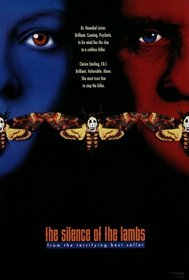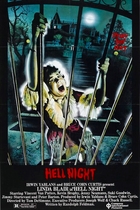Our editor-in-chief Nate Yapp is proud to have contributed to the new book Hidden Horror: A Celebration of 101 Underrated and Overlooked Fright Flicks, edited by Aaron Christensen. Another contributors include Anthony Timpone, B.J. Colangelo, Dave Alexander, Classic-Horror.com's own Robert C. Ring and John W. Bowen. Pick up a copy today from Amazon.com!
The Silence of the Lambs (1991)
The Silence of the Lambs should be read from a variety of perspectives. The film is most obviously a psychological thriller that features a range of psychiatric and psychological themes. The film also functions as a police procedural because it is narrated through the point of view of a fledgling FBI agent and walks viewers through the process of capturing a serial killer. There is enough gore and suspense to qualify, at least marginally, as a horror film, and to take that notion one step further, the infamous Dr. Hannibal Lecter could be viewed as one of the more eccentric "monsters" in recent film memory. But the list shouldn't stop there. Silence places a wonderful twist on the traditional detective narrative, with a young female, in this installment, extending the Sherlock Holmes/Philip Marlowe prototype. The film also works well as a "coming of age" student-mentor film, a psychopath film, and a feminist film.
Silence could also be considered one of the most important and successful films in the 1990s, standing in the same line as films such as Pulp Fiction and The Usual Suspects. The film won seven Academy Awards including nods for Actor and Actress in a Leading Role (Anthony Hopkins as Lecter and Jodie Foster as Clarice Starling), Directing (Jonathan Demme), Film Editing, Best Picture, Sound, and Writing. The film eventually launched a trilogy of successful (albeit inferior) Lecter films including Hannibal (2001) and Red Dragon (2002), and each featured a revived Hopkins, whose career was deservedly resurrected due to his outstanding performance in Silence (amazingly, he only appears in the film for roughly 16 minutes). Subsequent to the film's success, a rash of television shows featuring psychological profilers also emerged including "Profiler" and "Millennium," not to mention a flurry of psychopathic thrillers. If the film did anything, it loudly affirmed America's obsession with psychosis and the drive to understand its roots.
The story is based on Thomas Harris's popular novel of the same name. In fact, Lecter first appeared on celluloid in Michael Mann's Manhunter (1986), which is also based on a Harris novel titled "Red Dragon." The subsequent productions with Hopkins are also based on Harris's best-selling trilogy. Interestingly, the role of Lecter was originally offered to Gene Hackman, Robert Duvall, and Jeremy Irons. Starling's role was originally offered to Michelle Pfeiffer and Meg Ryan.
Foster plays Clarice Starling, a young, intelligent, ambitious student studying to become an FBI agent. Her boss and former teacher, Jack Crawford, sends her on a mission to question the paradoxical Lecter, a brilliant, world-renowned psychiatrist turned cannibal (his name aptly captures these contradictions - "Dr. Cannibal Lecturer"). Quickly, Lecter realizes Crawford's chicanery: he is using Starling as a pawn to hopefully extract information about the at-large serial killer Buffalo Bill. Lecter and Starling form a powerful bond, and as their relationship develops, they play each other for additional rewards: Lecter provides her valuable information about the killer, while Starling obtains provocative concessions for Lecter. However, when Lecter escapes a highly fortified, although makeshift prison, Starling is left alone. She accidentally stumbles upon the killer's home, and the film concludes with Starling's solo pursuit of the transvestite killer known as Buffalo Bill.
The film in many ways casts a holographic light on the fields of psychiatry and psychology. On one hand, the disciplines themselves are like characters that help solve crime, embodied in fragments by Starling, Crawford, and Lecter. The psychiatric and psychological complexities of major issues such as transvestitism, cannibalism, and the Electra complex, which emerges in Starling's obsession to emulate and overcome her father's failure as a police officer, to name just a few, are manifested throughout the film. However, the individuals who study these complexities, and the manners in which they are used, are highly suspect. Dr. Fredrick Chilton, the head of the Baltimore institute responsible for detaining Lecter, is a self-promoting, petty opportunist who thrives on publicizing his own merits while endangering the public he so eagerly wants to please. Lecter, of course, is a psychopath. And Crawford, who leads the FBI's behavioral profiling unit, abuses his power in that he withholds information from Starling and manipulates her to achieve ulterior motives. When juxtaposed against these three men, Starling is by far the most virtuous agent.
Furthermore, Silence condemns the labyrinth of male-dominated bureaucracies that enforce our laws. Chilton is the product of a male-dominated system that feeds on back-door deals, nepotism, and the "good-old-boy" buddy network. Crawford misuses his authority as Starling's teacher and supervisor and uses the young agent for his own personal gain. The FBI itself is depicted as an impersonal, bland castle full of sharp, rigid angles, and most noticeably, men, (in fact, the whole film is), that squawk and stare at the mere presence of a woman. This sexist attitude even filters down to local law enforcement agencies as depicted by the exhumation scene in West Virginia. The local cops wonder, "What the hell is she doing here?" as Starling examines a corpse and discovers a clue, the Tobacco hornworm moth, lodged in the mouth of the victim, which others, namely men, overlooked.
The opening scene, which according to Demme was suggested and created by Foster herself, does an excellent job of symbolically conveying this sexism. The film begins with a women running (seemingly from something - her past? A male-dominated profession?) alone through the woods. She hurdles obstacles on a course and mounts a hill, both of which are metaphors for the testosterone-filled hurdles Starling must overcome. It is no coincidence that Starling becomes most effective as a law enforcement official later in the film when she abandons her male colleagues altogether and pursues Buffalo Bill alone. Ironically, at the time the film was shot (in the early 1990s), Elizabeth Dole, Secretary of Labor under George H. Bush, allowed her office to be used as a double for Crawford's.
Depicting the monster, Lecter, as a cannibal is a provocative twist, but what separates Lecter from other cinematic demons is his paradoxical, antiheroic qualities. He is the ying and yang of the human spirit. He is an intellectual, artist, and recluse who represents the essence of power obtained not by hereditary, favoritism, or material wealth, but by the human mind. Through the power of his senses and intellect, Lecter can accomplish anything. He loves Renaissance paintings and classical music and has a penchant for fine foods and wines. Yet he is also an animal capable of base actions. Lecter is a living nightmare, one who can decipher its meaning but also play the role of Boogeyman. Like other cinematic psychopaths, he escapes, yet his escape is more plausible due to his ability to change identities, a skill fueled by his composure and intellect. He is a lunatic caged for prior transgressions that yearns for freedom but earns our forgiveness because he is willing to provide a public service to obtain it. However, he manipulates others and murders when the concessions do not satisfy his warped hunger. We our programmed to simultaneously love and hate his character.

And as detective film, Silence deserves high praise for massaging old conventions. Although she is not a detective, Starling becomes more and more of a "private" dick as the movie unfolds. Her abandonment of the FBI's protocol near the film's conclusion casts her more in the role of a cop turned private investigator. Usually, these cops turn this way out of a frustration for the rules and paperwork that paralyze police departments and other official law enforcement agencies. Starling is right in line with this tradition. She also has a sidekick like Sherlock Holmes or Poe's Auguste Dupin; however, her sidekick is a cannibalistic psychopath, an unusual twist to say the least.
Starling also has an entrepreneurial edge in that she is obsessively career oriented. A professional drive often fuels her ambition, and she wants to climb the corporate, or in this case, bureaucratic ladder, because as a women, she knows that financial freedom will lead to other types of freedom. And like many popular fictional detectives, from Dupin to Marlowe to J.J. Gittes in Roman Polanski's Chinatown, Starling is also haunted by her past. The crime that killed her father is similar to the "trap" she walks into with Buffalo Bill, but Starling overcomes this problem and does not repeat her past. Subsequently, she can "silence the lambs" or the metaphorical demons lurking in her memory.
Finally, the film also shines by placing a platonic twist on the traditional love triangle. Crawford, Starling, and Lecter are all competent professionals, and each is arguably obsessed with his or her profession. Their love is reflected not in sexual lust but in a passion for using psychology and psychiatry to enforce the law. As the student, Starling is placed at the apex of this love triangle with Crawford and Lecter jockeying for her professional attention As the movie progresses and Starling evolves, they also want her respect. Each male functions well as a sage mentor, and both men beguile the young agent to get what they want. However, Starling ultimately walks away with the grandest prize: the capture of Buffalo Bill and the publicity and professional accolades associated with such an accomplishment. Her relationship with each character is an original twist on an old cat-and-mouse game.
Silence is one of those films most Classic-Horror readers have already seen. However, the film deserves at least three or four viewings because it is as complex as its characters and their webs of psychosis. Time will reveal that this film was not only one of the best films of the 1990s, but one of the best thrillers in recent decades.
Trivia:
Buffalo Bill's quirky
behaviors are actually cherry-picked from three real serial
killers: Ed Gein, who notoriously skinned his victims; Ted Bundy,
who lured his victims into his van; and Gary Heidnick, who imprisoned
kidnapped women in a basement pit.
At least five "big name" directors actually appear
in the film. Foster and Hopkins have both directed, and Demme
is found at the film's conclusion wearing a blue cap. Horror
icons George Romero and Roger Corman also have cameos. Romero
is a logical reach because much of Silence was shot outside of
Pittsburgh, Romero's stomping grounds. He is a security guard
escorting Starling to Lecter in their final encounter. Corman
plays the FBI Director.








